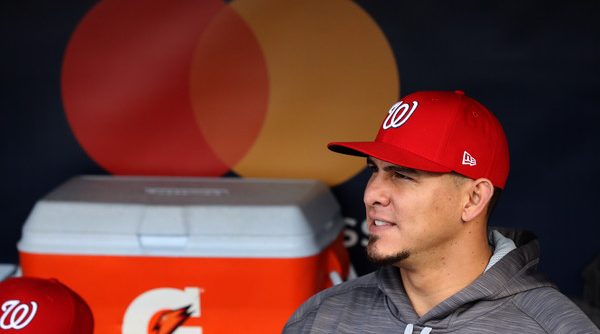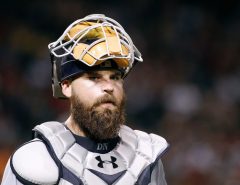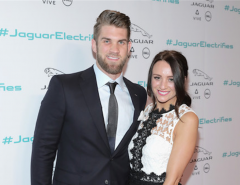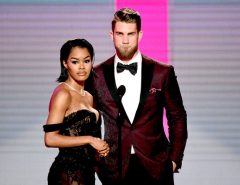This is the second of three parts in my offseason preview series. If you want to know more about the methodology, check out part one here. You should also just read it anyway! How did you even get to part two first?
Catchers
BR WAR Rank: #1
Room for improvement? Absolutely not
Wilson Ramos was incomparable this season, putting up a .307/.354/.496 line that gave him a better wRC+ than any other catcher in baseball. That’s in addition to his defensive prowess: He nailed 37.3 percent of attempted base-stealers, sixth-best in baseball. But he tore his ACL in late September — a cruel recurrence of the injuries that plagued him throughout his career before 2016. Instead of being a tremendous two-way catcher lined up for a big contract, he’s a backstop with two torn ACLs on his resume who will miss the first few months of 2017 and only has one above-average offensive season since 2014.
It’s not impossible for Ramos to return to the Nats, but the speculation has been that he would be best served going to the AL, where he can DH part-time and take some of the strain off his surgically repaired knee. If that’s so, the Nationals will certainly be outbid. Either way, it’s very hard to see the Nationals having the best catchers in baseball again in 2017. But how they choose to replace Ramos will determine just how far they slide back.
The cupboard is not bare: Jose Lobaton is a well-liked and serviceable, if light-hitting, backup. Pedro Severino draws breathless praise from noted Nats mouthpiece Tom Boswell, but his stats don’t exactly back up his reputation. That is, unless you only look at his (admittedly great!) 34 major league plate appearances this season.
Love this spin.
Career minor league numbers:
.243/ .294/ .338 pic.twitter.com/skJm5bnS5F— Internet Contrarian (@bogcommenter) November 14, 2016
For what it’s worth, the 22-year-old Severino ranks as the No. 14 prospect in the Nats organization according to MLB.com. That comes on the strength of his plus arm and glove — not his bat, which they rate as weak.
Even if the Nationals think Severino is three times the hitter he showed himself to be in the minors, not adding a catcher would be a mistake. If either Severino or Lobaton had to miss time, the only other close catching prospect in the organization is Spencer Kieboom. Pitchers reportedly love throwing to him, but he will be 26 next season, posted a .638 OPS at AA last year, and does not rank among MLB.com’s top 30 Nats prospects.
Unfortunately for the Nationals, the market is relatively barren. Matt Wieters is the prize of the non-Ramos division, but he posted an 88 wRC+ last year, will be 31 for the 2017 season, and has a long injury history that includes Tommy John. But FanGraphs predicts him to get two years and a palatable $28 million. The other notable catching FA is former Astro Jason Castro. Castro has had one good offensive season and it was in 2013, but he’s a year younger than Wieters and could be a below-average stopgap as a starter. Other free agents who are technically catchers include Nick Hundley, Alex Avila, and old friend Kurt Suzuki.
On the trade market, one option is already gone: Former Yankee and Brave Brian McCann was shipped to Houston. He has produced more than the likes of Wieters and Castro, but two years of his services required the Yankees to cover $11 million of his deal and returned two mediocre prospects, perhaps setting a benchmark for the catching market.
Mike Rizzo is a dealmaker, and it wouldn’t surprise me at all to see him pry some other team’s starting catcher away. But the options there aren’t great either: Among those who could conceivably be traded, some are more like DH types (Evan Gattis, Stephen Vogt) while you’d be betting on a bounceback with others (Yan Gomes, Derek Norris). Wieters is far from a sexy option, but he might be the best catcher not named Ramos out there.
First Basemen
BR WAR Rank: #29
Room for improvement? Yes
Ryan Zimmerman is the first-ever draft pick in Nationals history. He is the only player to play in all 12 of the team’s seasons in DC. He is owed $48 million through 2018, and he has full no-trade rights. If you ever had any notion of him being moved, get it out of your head. He’s not going anywhere.
That being said, Zimmerman was awful last year. He played in over 100 games for the first time since 2013 but responded by hitting .218/.272/.370. He will be 32 next season, so he is not yet over the hill, but time is running out for the franchise icon. He hung on to his starting role last season on the strength of great exit velocity numbers — that is, he hit the ball hard but was not rewarded for it. Of course, hard-hit balls aren’t worth much when the ball is being pounded into the ground, but the team kept holding out for a breakout that never came. Perhaps that exit velocity is a sign that Zimmerman still has it in him to hit the ball hard, but unless he improves on what he showed in 2016, it’s hard to see him starting at first base the entire season.
This is where the improvement comes in. If Zimmerman continues to struggle, or even just when he misses 40+ games due to injury, the Nats need a capable bat behind him. Clint Robinson was that in 2015, but he regressed across the board in 2016 en route to a .235/.305/.335 line. The role of backup first baseman and first (lefty) hitter off the bench is a big one on the Nationals, as evidenced by the fact that Robinson got into 104 games last season. So if the team can upgrade at that spot, it should jump at an opportunity to do so.
Fortunately for the team, in a very weak free agent class, the market is absolutely flush with backup first basemen. First, let’s assume that you want a lefty to replace Robinson because Chris Heisey is already your first righty pinch hitter, and you’ll want someone to platoon with Zimmerman if it comes to that. Perfect! There are already lots of great options. Let’s also say that it’s better if that player can play the outfield for versatility’s sake, though it’s not a necessity.
The best fit is probably Brandon Moss, who hit .225/.300/.484 with St. Louis last year and has been an above-average hitter in all but one season since becoming a regular in 2012. He’ll be 33 next season with a spotty health history, but if you want a good-hitting lefty who will accept a part-time role at first with a little left field sprinkled in, look no further. FanGraphs predicts he will get $11 million on a one-year deal, though I expect the Nats would rather give him a multi-year deal with a lower average value. As luck would have it, MLB Trade Rumors predicts Moss will sign with the Nationals on a two-year, $14 million deal.
Beyond Moss, Mitch Moreland is your second-best bet. He’s two years younger than Moss but has been a worse hitter over the years, coming out to about average for his career but hitting just .233/.298/.422 last year, or an 87 wRC+. He’s also never played the outfield, but should come cheaper. Pedro Alvarez will only be 30 in 2017 and has been an above-average hitter since 2012, including a .249/.322/.504 line in Baltimore last year, but he is such a bad fielder that he cost his team nearly three wins with his glove playing first for the 2015 Pittsburgh Pirates. Adam Lind will also be 33 next year and posted wRC+s of 132, 142, and 119 from 2013-15, but hit just .239/.286/.431 last year and can’t play the outfield. Logan Morrison is a league-average hitter and 1B/OF. Luis Valbuena is a strong-hitting lefty, but he has hardly ever played first. He is solid at third and could likely learn, but he may also seek a larger role somewhere. If you’re really digging down deep, Ryan Howard will be a free agent!
The stable of righties is similarly deep, if less of a natural fit. Mike Napoli had a 113 wRC+ for the AL champion Indians but will probably seek a full-time role for more money. Steve Pearce has raked everywhere he’s gone since 2013, including hitting .288/.374/.492 for the Rays and O’s last year. He can play the outfield too, but he’ll be 34 in 2017. Mark Reynolds is a familiar name, and he just had a decent season in Colorado.
But at the end of the day, a lefty makes the most sense, so I would expect the Nationals to pursue Moss, Moreland, and Lind if the money is right.
Second Basemen
BR WAR Rank: #4
Room for improvement? No
Not much to say here. Daniel Murphy was terrific in his first season as a Nat, and there’s no reason to believe his production will change much going into his age-32 season. He doesn’t have much of a backup at the moment, but a player like Valbuena could play second in a pinch, or the Nationals could re-sign Stephen Drew or add a similar player like Kelly Johnson or Aaron Hill.
Third Basemen
BR WAR Rank: #8
Room for improvement? No
Like second base, there isn’t much to say here. A return to health brought Anthony Rendon back to his 2014 levels of production, coming a paltry few points short of his OBP and SLG from his MVP-candidate year. He is a stellar third baseman and should continue being one for the foreseeable future.
But Rendon has a very extensive injury history, and the only potential for change in this ranking would be if he were to be hurt and miss time. The Nationals’ backup options at third are all but nonexistent right now, though re-signing Drew or adding a free agent like Valbuena would go a long way towards shoring that up.
Shortstops
BR WAR Rank: #18
Room for improvement? Yes
See Fielders, Center. This spot basically comes down to whether or not the Nationals decide to move Trea Turner from center field to shortstop or not.
Danny Espinosa was passable in 2016, with a paltry .209/.306/.378 line to cancel out his excellent glovework. Espinosa is what he is: a stellar defensive shortstop with some pop, but not much of a bat overall. That adds up to a below-average starter. In that same Bowden report where he predicts an attempt at Andrew Miller, he writes, “The Nationals love (Espinosa’s) glove, arm and power, but they’ve given up on his bat.” That sounds about right.
If Espinosa sticks around, this ranking should be basically the same. But at a projected $5.3 million salary, he could be a good opportunity for some cost-cutting if the Nats can find a suitable center field candidate and move Turner back to the infield.
Should Turner become the shortstop again, the sky is the limit for him. His defense earned solid reviews in the minors, and his bat will be even more valuable than it was in center. He will have a hard time maintaining his 147 wRC+ from his sensational rookie year, but even if that slips to 120 and he puts up average defense, he would produce roughly what Carlos Correa did in 2016. That’s a five-win player, or a 3-plus win upgrade on Espinosa, even before considering the value Turner adds with his blazing speed on the basepaths. Man, it’s hard to write more than a paragraph about Turner without getting excited about him.
Part three discusses the outfield, with targets for center field and why the biggest improvement the Nats can make won’t come through a trade or signing. You can find it here.
Tags: Aaron Hill, Adam Lind, Alex Avila, Anthony Rendon, Brandon Moss, Brian McCann, Chris Heisey, Clint Robinson, Daniel Murphy, Danny Espinosa, Derek Norris, Evan Gattis, Jason Castro, Jose Lobaton, Kelly Johnson, Kurt Suzuki, Logan Morrison, Luis Valbuena, Mark Reynolds, Matt Wieters, Mike Napoli, Mitch Moreland, Nationals, Nats, Nick Hundley, Pedro Alvarez, Pedro Severino, Ryan Howard, Ryan Zimmerman, Spencer Kieboom, Stephen Drew, Stephen Vogt, Steve Pearce, Trea Turner, Washington Nationals, Wilson Ramos, Yan Gomes




Leave a Reply